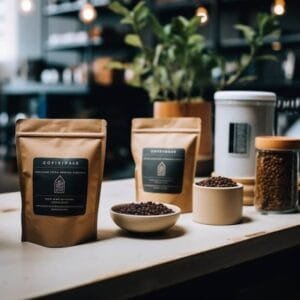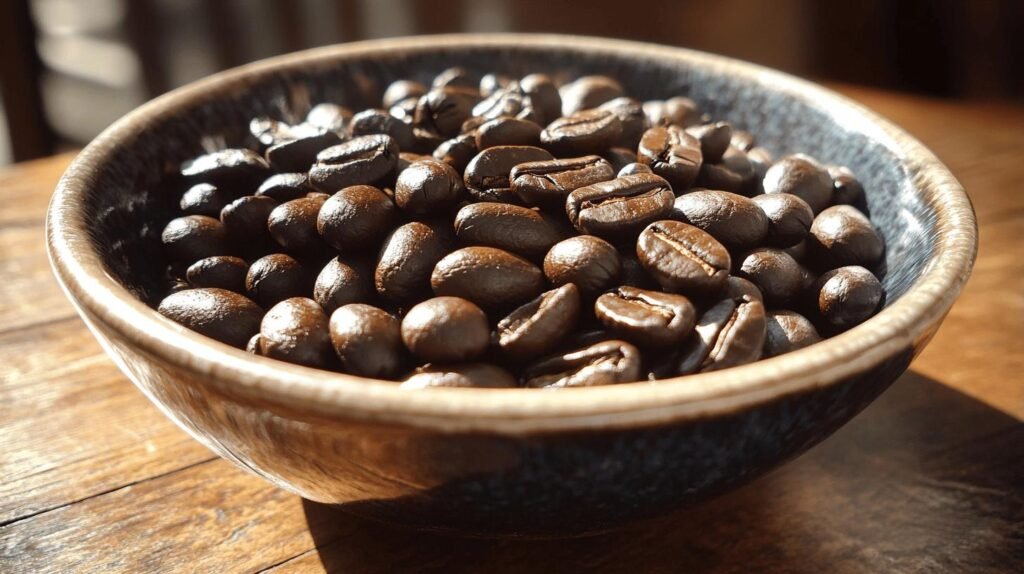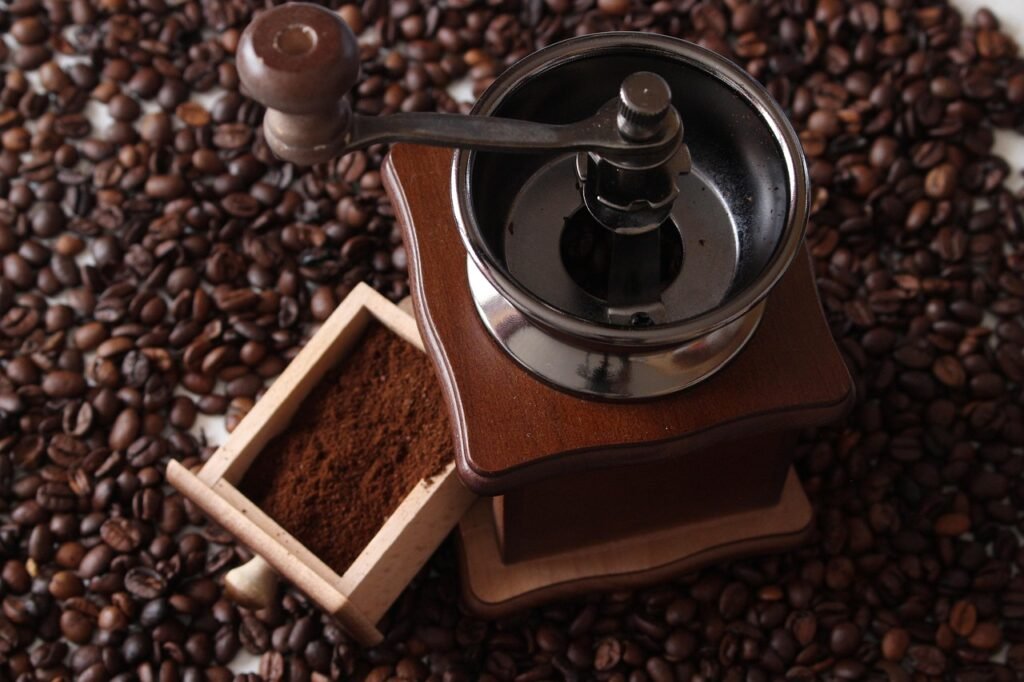Why settle for mild when you can have bold? If you crave a coffee that’s strong in flavor and high in caffeine, Robusta coffee beans are your go-to choice.
Known for their earthy, intense profile and nearly double the caffeine content of Arabica, Robusta beans pack a punch that stimulates the taste buds and energizes your day. Let’s uncover the robust world of Robusta coffee beans.
Characteristics and Taste Profile of Robusta Coffee Beans
Robusta coffee beans are known for their strong, earthy flavor and higher caffeine content, ranging from 18-20 mg/g. This high caffeine level gives Robusta its distinct bitterness and robustness.
The flavor is less acidic and more salty, offering a unique and intense coffee experience. Robusta coffee activates the “back palate” region of the taste buds, providing a deep, lingering aftertaste appreciated for its boldness.
When comparing Robusta to Arabica, the differences are clear. Arabica beans are sweeter, with a more complex flavor profile that includes hints of fruit and sugar. In contrast, Robusta beans offer a straightforward, bitter taste with notes resembling chocolate and nuts. This makes Robusta ideal for strong espresso blends, contributing to a thicker crema and a more assertive coffee flavor.
High-quality Robusta beans can be identified by their oval shape and straight cut, unlike the more curved cut of Arabica beans. This structural difference, combined with their unique taste, makes Robusta beans easily recognizable. For those seeking a coffee with a powerful kick and rich, deep flavors, Robusta is the go-to option.
Origins and Cultivation of Robusta Coffee Beans

Robusta coffee beans originated in Central and West Africa, with major cultivation starting in the Congo in the late 19th century. These beans are celebrated for their resilience, strength, and high productivity. Robusta thrives in low altitudes from 0 to 700 meters and flourishes in hot, humid equatorial climates. This adaptability allows Robusta to grow in regions where other coffee varieties might struggle.
Vietnam is the largest supplier of Robusta coffee beans, providing over 40% of global production. The country’s favorable climate and dedicated farming practices have cemented its leading producer status.
Other key contributors to the global supply include Brazil, Indonesia, India, and Uganda. These countries benefit from Robusta’s hardiness, requiring fewer herbicides and pesticides compared to more delicate varieties like Arabica.
Robusta plants are hardier and less vulnerable to pests and diseases, making them a more sustainable and cost-effective option for farmers. This resilience ensures a stable yield even under challenging conditions. The reduced need for chemical inputs not only benefits the environment but also supports more natural and organic coffee production.
Comparing Robusta vs. Arabica Coffee Beans
Robusta and Arabica coffee beans dominate the global coffee market, with Arabica accounting for about 60% of the supply and Robusta making up the remaining 40%. The primary differences between these two types lie in their taste profiles, caffeine content, acidity, and cultivation requirements.
Robusta beans are known for their strong, earthy flavor and higher caffeine content, ranging between 2.2% and 2.7%, compared to Arabica’s 1.2% to 1.5%. This high caffeine level contributes to Robusta’s characteristic bitterness and robustness, making it a popular choice for espresso blends. Robusta also contains more antioxidants (2.7%) compared to Arabica (1.5%), which can help reduce oxidative stress.
In contrast, Arabica beans are celebrated for their superior taste, which is sweeter and more complex. Arabica beans have more lipids and sugars, ranging from 6% to 9%, compared to Robusta’s 3% to 7%. This results in a smoother, more nuanced flavor with hints of fruit and floral notes. However, Arabica beans are more acidic, affecting the taste experience and making them less suitable for those who prefer a less acidic cup.
Robusta beans are often used in espresso blends to provide strength and a thicker crema. The robustness of Robusta complements the smoother, sweeter flavors of Arabica, creating a balanced and full-bodied espresso. Arabica beans, on the other hand, are more vulnerable to pests and diseases, requiring higher altitudes and more care to grow. This makes Arabica beans more expensive and labor-intensive to produce.
Key Differences Between Robusta and Arabica Coffee Beans:
- Caffeine Content: Robusta (2.2%-2.7%) vs. Arabica (1.2%-1.5%)
- Antioxidants: Robusta (2.7%) vs. Arabica (1.5%)
- Sugar Content: Robusta (3%-7%) vs. Arabica (6%-9%)
- Taste Profile: Robusta (bitter, earthy) vs. Arabica (sweet, complex)
- Usage: Robusta (espresso blends) vs. Arabica (specialty coffee)
- Cultivation Requirements: Robusta (low altitudes, disease-resistant) vs. Arabica (high altitudes, pest-vulnerable)
Health Benefits and Side Effects of Robusta Coffee Beans

Robusta coffee beans have a higher antioxidant content which can help combat oxidative stress and protect cells from damage. These antioxidants neutralize harmful free radicals, contributing to overall health.
Also, the high caffeine level in Robusta coffee beans can enhance alertness and provide a stronger energy boost, making Robusta a popular choice for those needing a quick pick-me-up.
However, the high caffeine content comes with potential side effects. Consuming large amounts of caffeine can lead to jitteriness, increased heart rate, and insomnia. Those sensitive to caffeine should be cautious to avoid these adverse effects.
In addition to antioxidants, Robusta beans contain compounds that may support cardiovascular health. Regular consumption can improve blood circulation and reduce the risk of certain heart conditions.
Brewing Tips for Robusta Coffee Beans
Robusta coffee beans are a popular choice for espresso due to their robust flavor and high caffeine content. Proper grinding is crucial for the best taste.
For drip coffee, a medium to coarse grind is recommended. This grind size ensures optimal extraction and highlights the strong, earthy notes characteristic of Robusta beans. For espresso, a fine grind is ideal. The finer the grind, the more surface area is exposed to water, allowing for a richer, more concentrated flavor.
When using a French press, opt for a coarse grind. This prevents over-extraction and produces a balanced brew. Steep the coffee for about four minutes to extract the bold flavors without introducing too much bitterness. The robust nature of Robusta beans makes them perfect for this brewing method, delivering a full-bodied coffee experience.
High-quality Robusta beans provide a rich crema in espresso. This creamy layer enhances the texture and taste of the espresso shot. Using fresh, high-quality beans enhances the flavor and aroma, making your coffee experience more enjoyable.
To get the best results, always store your beans in an airtight container away from light and moisture.
Steps for Brewing an Excellent Robusta Espresso:
- Use fresh, high-quality Robusta beans.
- Grind the beans to a fine consistency.
- Use 18-20 grams of ground coffee for a double shot.
- Tamp the coffee evenly to ensure consistent extraction.
- Brew at a water temperature of 195-205°F for optimal flavor.
Where to Buy High-Quality Robusta Coffee Beans

High-quality Robusta coffee beans can be found from various small and medium businesses that prioritize bean quality and ethical practices. Nguyen Coffee Supply’s Truegrit Peaberry Robusta is notable, available on Amazon for around $19.99 for a 12 oz package. These beans are praised for their robust flavor and high caffeine content.
Small business brands often provide locally sourced Robusta beans with certifications like Fair Trade, Organic, and Non-GMO, ensuring consumers get a premium product while supporting sustainable farming practices.
E-subscription services are another excellent way to get high-quality Robusta beans. These services offer regular deliveries, allowing customers to enjoy freshly roasted beans tailored to their preferences. Subscribing often means access to exclusive blends and limited-edition roasts, enhancing the overall coffee experience.
Final Words
Exploring the robust flavors and characteristics of Robusta coffee beans, one discovers their strong, earthy taste and high caffeine content. For those seeking high-quality beans, many reputable brands and online sources offer excellent Robusta options.
While Robusta beans are often used in espresso blends for their strength, they also offer unique health benefits and potential side effects due to their higher caffeine content.
Understanding the unique profile of robusta coffee beans allows enthusiasts to enjoy a more balanced and flavorful coffee experience.
FAQs
What coffee beans are Robusta?
Robusta coffee beans are known for their strong, earthy flavor and high caffeine content, ranging between 18-20 mg/g. They are less acidic, more salty, and have more caffeine compared to Arabica beans.
Which coffee is better, Robusta or Arabica?
Robusta coffee has a stronger, more bitter taste and higher caffeine content, while Arabica is generally considered to have a superior, sweeter, and more complex flavor profile with higher lipid and sugar content.
Why don’t stores like Robusta coffee?
Many stores prefer Arabica over Robusta due to Arabica’s smoother flavor profile and general consumer preference for its sweetness and lower bitterness.
Is Robusta coffee high in caffeine?
Yes, Robusta coffee has a high caffeine content, approximately 2.7%, almost double that of Arabica beans, which average around 1.5%. This makes it more stimulating and potent.














